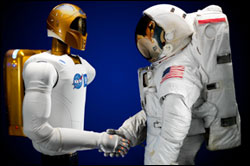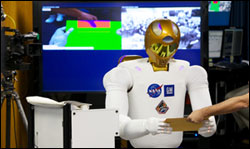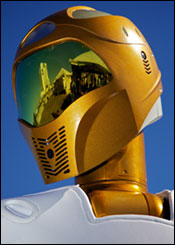
Robonaut Features Advanced Vision
When the space shuttle Discovery returned recently after its last mission to the International Space Station, it left behind a passenger that will never return to Earth. Astronauts on the mission delivered a humanoid robot dubbed Robonaut 2, a highly dexterous machine that includes advanced vision capabilities combining time-of-flight and stereoscopic vision.

Robonaut meets astronaut. (Photos: NASA)
The robonaut’s eyes for stereoscopic vision are two Prosilica GC2450 devices made by Allied Vision Technologies GmbH. Built in partnership with General Motors and the Oceaneering Space Systems of Houston, NASA’s Robonaut is the second generation of highly dexterous humanoid robots designed to work alongside humans and execute simple, repetitive or dangerous tasks on Earth or onboard the International Space Station.

Testing the robonaut’s vision.
R2’s vision equipment is housed inside its helmet. The system uses color, pixel intensity and texture-based segmentation as well as advanced pattern-recognition techniques to extract the necessary information. To simplify the procedure, the robot’s vision system focuses on certain areas of the image using regions of interest, a function that allows a portion of the available pixels to be read out from the camera, resulting in a much faster frame rate and less data to be processed.

Close-up view of the robonaut.
In addition, the time-of-flight sensor data allows the background to be removed to focus on the object of interest (tools, boxes, etc.). Built-in classification techniques within the software are used to perform 3-D and pattern-recognition functions in real time to allow R2 to compute feasible trajectories and decide where to place its hands to execute a set of predetermined tasks, such as opening boxes autonomously.
Developed in 1997, the first generation of Robonaut (R1) was a humanlike robotic assistant capable of performing simple maintenance tasks. R2 is a fully modular 300-lb robot that consists of a head and a torso with two arms and two hands. R2’s many technological improvements include an improved range of sensors that feature the aforementioned color cameras from Allied Vision as well as an infrared time-of-flight camera. R2 has 350 sensors (for tactile, force, position, range finding and vision sensing) and 38 power PC processors, enabling it to perform functions such as object recognition and manipulation. It also can react to its surroundings and operate semiautonomously.

The International Space Station, where Robonaut 2 will forever reside.
Other generational improvements include optimized overlapping dual-arm dexterous workspace, series elastic joint technology, extended finger and thumb travel, miniaturized six-axis load cells, redundant force sensing, ultrahigh-speed joint controllers and extreme neck travel. Capable of 42 degrees of freedom (including 24 in its hands and fingers alone) R2’s dexterity allows it to use the same tools as astronauts, removing the need for robot-specific tools.
For more information, visit: www.alliedvisiontec.com
/Buyers_Guide/Allied_Vision_Technologies_GmbH/c569